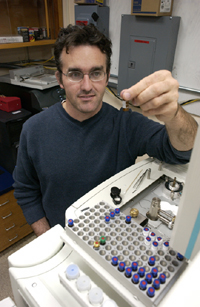Shelley DawickiNovember 7, 2002Source: Media RelationsThirty years after approximately 175,000 gallons of No. 2 fuel oil spilled from the barge FLORIDA in Buzzards Bay near West Falmouth, MA, residues of the oil can still be found in salt marsh sediments, according to a report to be released November 15 by scientists at the Woods Hole Oceanographic Institution (WHOI) and colleagues at the U.S. Coast Guard Academy. Their findings, to appear in the journal Environmental Science and Technology published by the American Chemical Society, provide further evidence that oil persists in the marine environment for a long period of time even though the surface sediments recover quickly and appear visually healthy. Lead study author Christopher Reddy, an assistant scientist in the Institution's Marine Chemistry and Geochemistry Department, and colleagues collected a 36- centimeter (14-inch) sediment core from the West Falmouth site in August 2000. No evidence of petroleum residues were detected in the top six centimeters (just over two inches) or the lower eight centimeters (roughly three inches) of the core. However, the central section of the sediment core, from six to 28 centimeters (two to 11 inches from the top of the core) contained petroleum hydrocarbons in similar concentrations to those observed shortly after the1969 spill. Using new analytical methods not available in prior studies at the site, the team found that compounds consistent with No. 2 fuel oil were still present in the sediments and may remain there indefinitely. The West Falmouth oil spill site, specifically at Wild Harbor, has been studied extensively since the September 16, 1969 oil spill and is a considered a baseline for studies of the long-term fate and effects of petroleum hydrocarbons in marine sediments. Scientists have been studying the site regularly since the spill occurred and have found similar results each time. A 1989 study, for example, confirmed the presence of oil residues in the sediments, attributed to the heavy contamination of the area by the oil spill, the high organic carbon content, and anoxic conditions in the salt marsh sediments that hindered microbial degradation. Reddy and his department colleagues Timothy Eglinton, Aubrey Hounshell, Helen White and Li Xu have begun a major effort to revisit the Wild Harbor site and to investigate the fate of the spilled oil using new analytical approaches that were not available in prior studies. The Woods Hole team conducted the most recent study in collaboration with Richard Gaines and Glenn Frysinger of the Department of Science at the U.S. Coast Guard Academy using gas chromatography and comprehensive two-dimensional gas chromatography. The more precise comprehensive two-dimensional gas chromatography, which is capable of separating one order of magnitude more compounds than the traditional gas chromatography method, was used in laboratory analysis to observe whether any compositional changes occurred in the sample. The recent study was funded by the National Science Foundation and the Robert T. Alexander Trust. "Petroleum residues from the spill continue to occur in Wild Harbor sediments after 30 years and will likely remain there indefinitely," Reddy says. "Even after all these years, concentrations of some compounds are similar to those observed immediately after the spill and reflect the persistent nature of No, 2 fuel oil in coastal salt marsh sediments. The long-term biological effects of oil contamination at this site is unknown since animals burrowing into these sediments can be exposed to high levels of some of these compounds. It is clear from this study that oil spills can have a long-term impact on a coastal environment." Originally published: November 7, 2002 Last updated: July 28, 2014 | ||||||||||||||||||
Copyright ©2007 Woods Hole Oceanographic Institution, All Rights Reserved, Privacy Policy. | ||||||||||||||||||


